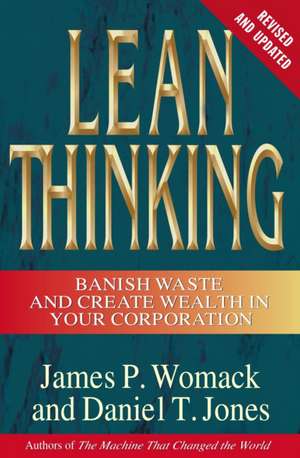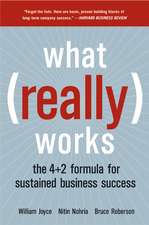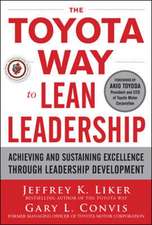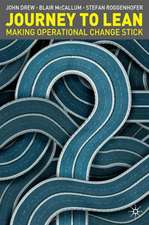Lean Thinking: Banish Waste and Create Wealth in Your Corporation, Revised and Updated
Autor James P. Womack, Daniel T. Jonesen Limba Engleză Hardback – 31 mai 2003
Expanded, updated, and more relevant than ever, this bestselling business classic by two internationally renowned management analysts describes a business system for the twenty-first century that supersedes the mass production system of Ford, the financial control system of Sloan, and the strategic system of Welch and GE. It is based on the Toyota (lean) model, which combines operational excellence with value-based strategies to produce steady growth through a wide range of economic conditions.
In contrast with the crash-and-burn performance of companies trumpeted by business gurus in the 1990s, the firms profiled in "Lean Thinking" -- from tiny Lantech to midsized Wiremold to niche producer Porsche to gigantic Pratt & Whitney -- have kept on keeping on, largely unnoticed, along a steady upward path through the market turbulence and crushed dreams of the early twenty-first century. Meanwhile, the leader in lean thinking -- Toyota -- has set its sights on leadership of the global motor vehicle industry in this decade.
Instead of constantly reinventing business models, lean thinkers go back to basics by asking what the customer really perceives as "value." (It's often not at all what existing organizations and assets would suggest.) The next step is to line up value-creating activities for a specific product along a "value stream" while eliminating activities (usually the majority) that don't add value. Then the lean thinker creates a "flow" condition in which the design and the product advance smoothly and rapidly at the "pull" of the customer (rather than the push of the producer). Finally, as flow and pull are implemented, the lean thinker speeds up the cycle of improvement in pursuit of "perfection." The first part of this book describes each of these concepts and makes them come alive with striking examples.
"Lean Thinking" clearly demonstrates that these simple ideas can breathe new life into any company in any industry in any country. But most managers need guidance on how to make the lean leap in their firm. Part II provides a step-by-step action plan, based on in-depth studies of more than fifty lean companies in a wide range of industries across the world.
Even those readers who believe they have embraced lean thinking will discover in Part III that another dramatic leap is possible by creating an extended lean enterprise for each of their product families that tightly links value-creating activities from raw materials to customer.
In Part IV, an epilogue to the original edition, the story of lean thinking is brought up-to-date with an enhanced action plan based on the experiences of a range of lean firms since the original publication of "Lean Thinking."
"Lean Thinking" does not provide a new management "program" for the one-minute manager. Instead, it offers a new method of thinking, of being, and, above all, of doing for the serious long-term manager -- a method that is changing the world.
Preț: 205.71 lei
Recomandat Nou
39.36€ • 41.21$ • 32.57£
Carte disponibilă
Livrare economică 17-31 martie
Specificații
ISBN-10: 0743249275
Pagini: 400
Dimensiuni: 163 x 241 x 31 mm
Greutate: 0.59 kg
Ediția:Free Press.
Editura: Free Press
Recenzii
Philip Caldwell Chairman and CEO, Ford Motor Company, 1980-1985 Truly remarkable....The most comprehensive, instructive, mind-stretching and provocative analysis of any major industry I have ever known. Why pay others huge consulting fees? Just read this book.
Richard J. Schonberger Author of "World Class Manufacturing: The Next Decade" The manufacturing book of the nineties.
"Automotive News" This is a book of great understanding, and of hope. It shows how to create an industrial world in which workers share the challenges and satisfactions of the business. It's a world in which assemblers communicate with suppliers and dealers in a way that improves life for all of them. Read it.
Peter F. Drucker Author of "The Post-Capitalist Society""The Machine That Changed the World" is a very important book. I am impressed.
"Business Week" The best current book on the changes reshaping manufacturing, and the most readable, too...conveys a very human sense of managers constrained by limited resources yet trying to do better.
"Financial Times" A revealing and compellingly readable account of Japan's achievement in revolutionizing manufacturing....An eye-opener even for those who already knew Japan didn't do it all with robots.
Descriere
Expanded, updated, and more relevant than ever, this bestselling business classic by two internationally renowned management analysts describes a business system for the twenty-first century.
Expanded, updated, and more relevant than ever, this bestselling business classic by two internationally renowned management analysts describes a business system for the twenty-first century that supersedes the mass production system of Ford, the financial control system of Sloan, and the strategic system of Welch and GE. It is based on the Toyota (lean) model, which combines operational excellence with value-based strategies to produce steady growth through a wide range of economic conditions.
In contrast with the crash-and-burn performance of companies trumpeted by business gurus in the 1990s, the firms profiled in "Lean Thinking" -- from tiny Lantech to midsized Wiremold to niche producer Porsche to gigantic Pratt & Whitney -- have kept on keeping on, largely unnoticed, along a steady upward path through the market turbulence and crushed dreams of the early twenty-first century. Meanwhile, the leader in lean thinking -- Toyota -- has set its sights on leadership of the global motor vehicle industry in this decade.
Instead of constantly reinventing business models, lean thinkers go back to basics by asking what the customer really perceives as "value." (It's often not at all what existing organizations and assets would suggest.) The next step is to line up value-creating activities for a specific product along a "value stream" while eliminating activities (usually the majority) that don't add value. Then the lean thinker creates a "flow" condition in which the design and the product advance smoothly and rapidly at the "pull" of the customer (rather than the push of the producer). Finally, as flow and pull are implemented, the lean thinker speeds up the cycle of improvement in pursuit of "perfection." The first part of this book describes each of these concepts and makes them come alive with striking examples.
"Lean Thinking" clearly demonstrates that these simple ideas can breathe new life into any company in any industry in any country. But most managers need guidance on how to make the lean leap in their firm. Part II provides a step-by-step action plan, based on in-depth studies of more than fifty lean companies in a wide range of industries across the world.
Even those readers who believe they have embraced lean thinking will discover in Part III that another dramatic leap is possible by creating an extended lean enterprise for each of their product families that tightly links value-creating activities from raw materials to customer.
In Part IV, an epilogue to the original edition, the story of lean thinking is brought up-to-date with an enhanced action plan based on the experiences of a range of lean firms since the original publication of "Lean Thinking."
"Lean Thinking" does not provide a new management "program" for the one-minute manager. Instead, it offers a new method of thinking, of being, and, above all, of doing for the serious long-term manager -- a method that is changing the world.
Cuprins
Contents
Preface to the 2003 Edition
Preface to the First Edition: From Lean Production to Lean Enterprise
PART I: LEAN PRINCIPLES
Introduction: Lean Thinking versus Muda
1. Value
2. The Value Stream
3. Flow
4. Pull
5. Perfection
PART II: FROM THINKING TO ACTION: THE LEAN LEAP
6. The Simple Case
7. A Harder Case
8. The Acid Test
9. Lean Thinking versus German Technik
10. Mighty Toyota; Tiny Showa
11. An Action Plan
PART III: LEAN ENTERPRISE
12. A Channel for the Stream; a Valley for the Channel
13. Dreaming About Perfection
PART IV: EPILOGUE
14. The Steady Advance of Lean Thinking
15. Institutionalizing the Revolution
Afterword: The Lean Network
Appendix: Individuals and Organizations Who Helped
Glossary
Notes
Bibliography
Index














